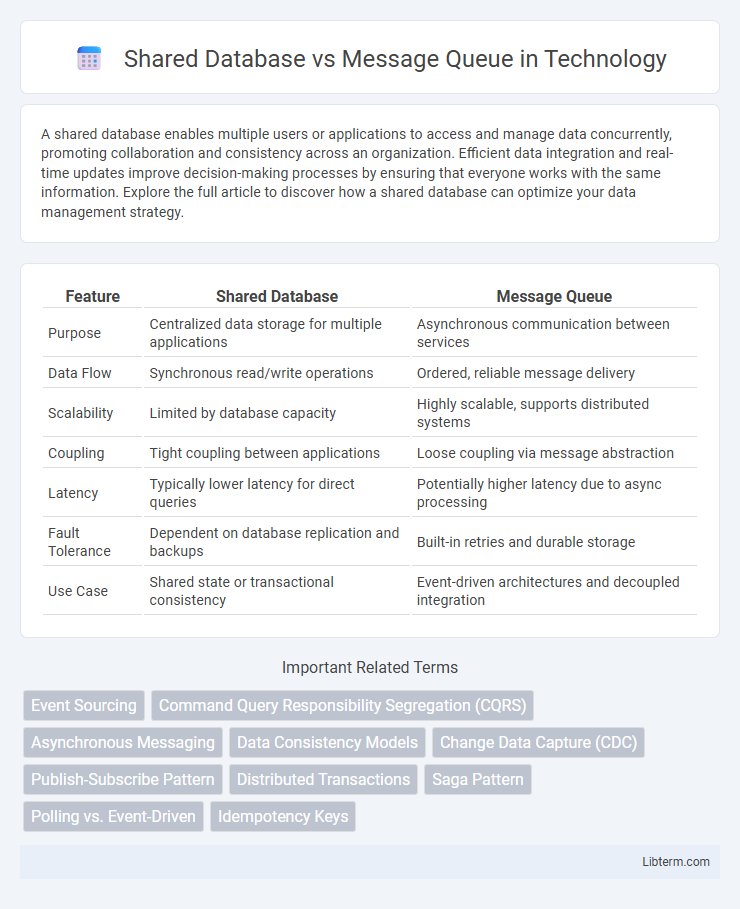A shared database enables multiple users or applications to access and manage data concurrently, promoting collaboration and consistency across an organization. Efficient data integration and real-time updates improve decision-making processes by ensuring that everyone works with the same information. Explore the full article to discover how a shared database can optimize your data management strategy.
Table of Comparison
| Feature | Shared Database | Message Queue |
|---|---|---|
| Purpose | Centralized data storage for multiple applications | Asynchronous communication between services |
| Data Flow | Synchronous read/write operations | Ordered, reliable message delivery |
| Scalability | Limited by database capacity | Highly scalable, supports distributed systems |
| Coupling | Tight coupling between applications | Loose coupling via message abstraction |
| Latency | Typically lower latency for direct queries | Potentially higher latency due to async processing |
| Fault Tolerance | Dependent on database replication and backups | Built-in retries and durable storage |
| Use Case | Shared state or transactional consistency | Event-driven architectures and decoupled integration |
Introduction to Shared Database and Message Queue
A Shared Database allows multiple applications or services to access and modify the same data storage, enabling real-time data consistency but often leading to tight coupling and potential contention issues. A Message Queue enables asynchronous communication between decentralized components by passing messages through a broker, which decouples producers and consumers and enhances system scalability and reliability. Choosing between Shared Database and Message Queue depends on system design requirements such as data consistency, performance, and scalability.
Core Concepts: How Shared Databases Work
Shared databases function by allowing multiple applications to access and modify the same data store concurrently, ensuring data consistency through transactions and locking mechanisms. This approach centralizes data management, enabling direct read and write operations but can lead to contention and scalability challenges under high load. Core concepts include atomicity, consistency, isolation, and durability (ACID) properties that maintain data integrity across multiple users and processes.
Core Concepts: How Message Queues Work
Message queues operate by enabling asynchronous communication between distributed systems through a queue that stores messages until they are processed by a receiver. Producers send messages to the queue without waiting for immediate processing, ensuring decoupling and scalability, while consumers retrieve and process these messages independently. This mechanism supports reliable data exchange, load balancing, and fault tolerance, contrasting with the tight coupling inherent in shared database architectures.
Use Cases: When to Choose a Shared Database
A shared database is ideal for scenarios requiring strong consistency and transactional integrity across multiple services, such as financial systems or inventory management where real-time data accuracy is critical. It supports complex queries and relational data models, making it suitable for applications that depend heavily on structured data with direct access needs. Choose a shared database when services must operate on a unified dataset with immediate visibility and update capabilities rather than asynchronous communication.
Use Cases: When to Choose a Message Queue
Message queues excel in asynchronous communication scenarios where tasks must be decoupled to ensure scalability and fault tolerance, such as order processing systems and real-time data streaming. They enable reliable message delivery and workload distribution across multiple consumers, ideal for microservices architectures requiring loose coupling. Choose a message queue when system components need to operate independently without direct database contention, ensuring smooth handling of high-throughput and time-sensitive workloads.
Performance Comparison: Latency and Throughput
Shared databases often exhibit higher latency due to disk I/O and locking contention, which can limit transaction throughput under heavy loads. Message queues provide lower latency by decoupling producers and consumers, enabling asynchronous processing and higher throughput through parallelism. However, the performance benefits of message queues depend on efficient broker architecture and network conditions, while shared databases may suffer from scalability bottlenecks during peak usage.
Scalability and Flexibility Considerations
Shared databases often struggle with scalability due to centralized contention and limited horizontal partitioning options, making them less flexible for distributed systems. In contrast, message queues support high scalability by enabling asynchronous communication and decoupling components, which enhances system flexibility and resilience. Message queues also allow dynamic scaling of consumers and better load balancing, facilitating more adaptable and performant architectures.
Data Consistency and Reliability
Shared databases ensure strong data consistency by centralizing information in a single repository, which allows immediate visibility and atomic transactions but can create bottlenecks under high concurrency. Message queues enhance reliability through asynchronous processing, decoupling producers and consumers to prevent data loss and enabling guaranteed message delivery with retries and persistence. Balancing shared databases and message queues depends on the application's tolerance for latency, consistency requirements, and fault tolerance needs.
Failure Handling and Error Recovery
Shared databases enable direct data consistency but complicate failure handling due to tight coupling and potential database locks, making error recovery slower and more prone to cascading failures. Message queues decouple producers and consumers, improving failure isolation by allowing messages to be retried, delayed, or dead-lettered without disrupting other components. Error recovery in message queues often leverages automatic retries and compensating transactions, ensuring higher system resilience and easier fault isolation compared to shared databases.
Making the Right Choice for Your Architecture
Choosing between a shared database and a message queue depends on your system's scalability, latency, and data consistency needs. Shared databases offer strong consistency and simplified data access, ideal for tightly coupled architectures requiring transactional integrity. Message queues provide asynchronous communication and decoupling, supporting high scalability and fault tolerance in distributed systems where eventual consistency is acceptable.
Shared Database Infographic

 libterm.com
libterm.com